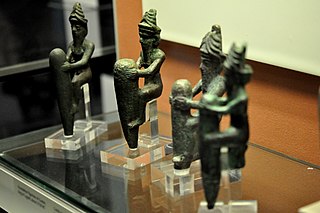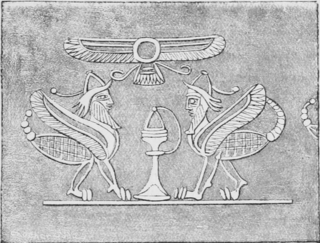 W
WThe Epic of Gilgamesh is an epic poem from ancient Mesopotamia, regarded as the earliest surviving notable literature and the second oldest religious text, after the Pyramid Texts. The literary history of Gilgamesh begins with five Sumerian poems about Bilgamesh, king of Uruk, dating from the Third Dynasty of Ur. These independent stories were later used as source material for a combined epic in Akkadian. The first surviving version of this combined epic, known as the "Old Babylonian" version, dates to the 18th century BC and is titled after its incipit, Shūtur eli sharrī. Only a few tablets of it have survived. The later Standard Babylonian version compiled by Sîn-lēqi-unninni dates from the 13th to the 10th centuries BC and bears the incipit Sha naqba īmuru. Approximately two-thirds of this longer, twelve-tablet version have been recovered. Some of the best copies were discovered in the library ruins of the 7th-century BC Assyrian king Ashurbanipal.
 W
WGilgamesh was a major hero in ancient Mesopotamian mythology and the protagonist of the Epic of Gilgamesh, an epic poem written in Akkadian during the late 2nd millennium BC. He was likely a historical king of the Sumerian city-state of Uruk, who was posthumously deified. His rule probably would have taken place sometime in the beginning of the Early Dynastic Period (Mesopotamia), c. 2900 – 2350 BC, though he became a major figure in Sumerian legend during the Third Dynasty of Ur.
 W
WAga (Sumerian:𒀝𒂵) commonly known as Aga of Kish, was the twenty-third and last king in the first dynasty of Kish during Early Dynastic I. He is listed in the Sumerian King List and many sources as the son of Enmebaragesi. The Kishite king ruled the city at its peak, probably reaching beyond the territory of Kish, including Umma and Zabala. The Sumerian poem Gilgamesh and Aga records the Kishite siege of Uruk after its lord Gilgamesh refused to submit to Aga, ending in Aga's defeat and consequently the fall of Kish's hegemony.
 W
WThe Anunnaki are a group of deities of the ancient Sumerians, Akkadians, Assyrians, and Babylonians. In the earliest Sumerian writings about them, which come from the Post-Akkadian period, the Anunnaki are deities in the pantheon, descendants of An and Ki, the god of the heavens and the goddess of earth, and their primary function was to decree the fates of humanity.
 W
WAtra-Hasis is an 18th-century BCE Akkadian epic, recorded in various versions on clay tablets, named for its protagonist, Atrahasis. The Atra-Hasis tablets include both a creation myth and one of three surviving Babylonian flood myths. The name "Atra-Hasis" also appears, as king of Shuruppak in the times before a flood, on one of the Sumerian King Lists.
 W
WIn ancient Mesopotamian mythology, the Bull of Heaven is a mythical beast fought by the hero Gilgamesh. The story of the Bull of Heaven has two different versions: one recorded in an earlier Sumerian poem and a later version in the standard Akkadian Epic of Gilgamesh. In the Sumerian poem, the Bull is sent to attack Gilgamesh by the goddess Inanna for reasons that are unclear. The more complete Akkadian account comes from Tablet VI of the Epic of Gilgamesh, in which Gilgamesh rejects the sexual advances of the goddess Ishtar, the East Semitic equivalent of Inanna, leading the enraged Ishtar to ask her father Anu for the Bull of Heaven, so that she may send it to attack Gilgamesh in Uruk. Anu gives her the Bull and she sends it to attack Gilgamesh and his companion, the hero Enkidu, who slay the Bull together.
 W
WThe Cedar Forest is the glorious realm of the gods of Mesopotamian mythology. It is guarded by the demigod Humbaba and was once entered by the hero Gilgamesh who dared cut down trees from its virgin stands during his quest for fame. The Cedar Forest is described in Tablets 4–6 of the great Epic of Gilgamesh.
 W
WThe Cedars of God, located in the Kadisha Valley of Bsharre, Lebanon, are one of the last vestiges of the extensive forests of the Lebanon cedar that anciently thrived across Mount Lebanon. All early modern travelers' accounts of the wild cedars appear to refer to the ones in Bsharri; the Christian monks of the monasteries in the Kadisha Valley venerated the trees for centuries. The earliest documented references of the Cedars of God are found in Psalms of King David eg. "104:16". These references provide support to claims of the creation story's proximity to the Cedars forest, firstly the planting of Cedars with Gods hands and secondly the name of an adjacent village in the Kadisha Valley known as Edhen (Eden).
 W
WCedrus libani, the cedar of Lebanon or Lebanese cedar, is a species of tree in the pine family Pinaceae, native to the mountains of the Eastern Mediterranean basin. It is a large evergreen conifer that has great religious and historical significance in the cultures of the Middle East, and is referenced many times in the literature of ancient civilisations. It is the national emblem of Lebanon and is widely used as an ornamental tree in parks and gardens.
 W
WEnkidu (Sumerian: 𒂗𒆠𒄭 EN.KI.DU10) was a legendary figure in ancient Mesopotamian mythology, wartime comrade and friend of Gilgamesh, king of Uruk. Their exploits were composed in Sumerian poems and in the Akkadian Epic of Gilgamesh, written during the 2nd millennium BC. He is the oldest literary representation of the wild man, a recurrent motif in artistic representations in Mesopotamia and in Ancient Near East literature. The apparition of Enkidu as a primitive man seems to be an innovation of the Old Babylonian version (1300 - 1000 BC), as he was originally a servant-warrior in the Sumerian poems.
 W
WThe Gilgamesh flood myth is a flood myth in the Epic of Gilgamesh. Many scholars believe that the flood myth was added to Tablet XI in the "standard version" of the Gilgamesh Epic by an editor who used the flood story from the Epic of Atrahasis. A short reference to the flood myth is also present in the much older Sumerian Gilgamesh poems, from which the later Babylonian versions drew much of their inspiration and subject matter.
 W
WIn Ancient Mesopotamian religion, Humbaba, also spelled Huwawa and surnamed the Terrible, was a monstrous giant of immemorial age raised by Utu, the Sun / justice / truth god. Humbaba was the guardian of the Cedar Forest, where the gods lived, by the will of the god Enlil, who"assigned [Humbaba] as a terror to human beings. Gilgamesh and Enkidu defeated this great enemy."
 W
WLugalbanda was a deified Sumerian king of Uruk who, according to various sources of Mesopotamian literature, was the father of Gilgamesh. Early sources mention his consort Ninsun and his heroic deeds in an expedition to Aratta by King Enmerkar.
 W
WIn Sumerian mythology, Ninsun is a goddess, best known as the mother of the legendary hero Gilgamesh, and as the tutelary goddess of Gudea of Lagash. Her parents are the deities Anu and Uras. Ninsun has also been linked to older deities.
 W
WScorpion men are featured in several Akkadian language myths, including the Enûma Elish and the Babylonian version of the Epic of Gilgamesh. They were also known as aqrabuamelu or girtablilu. The Scorpion Men are described to have the head, torso, and arms of a man and the body of a scorpion.
 W
WShamhat is a female character who appears in Tablets I and II of the Epic of Gilgamesh and is mentioned in Tablet VII. She is a sacred prostitute who plays a significant role in bringing the wild man Enkidu into contact with civilization.
 W
WSiduri is a character in the Epic of Gilgamesh. She is an "alewife", a wise female divinity associated with fermentation.
 W
WSîn-lēqi-unninni (Akkadian: 𒁹𒀭𒌍𒋾𒀀𒅆 md30-TI-ER2) was a mašmaššu who lived in Mesopotamia, probably in the period between 1300 BC and 1000 BC. He is traditionally thought to have compiled the best-preserved version of the Epic of Gilgamesh. His name is listed in the text itself, which was unorthodox for works written in cuneiform. His version is known by its incipit, or first line "ša nagba īmuru" ("He who saw the deep" or "The one who saw the Abyss"). The extent to which his version is different from earlier texts is unknown; Andrew R. George argues that Sîn-lēqi-unninni "gave [The Epic of Gilgamesh] its final, fixed form".
 W
WUruk was an ancient city of Sumer situated east of the present bed of the Euphrates River on the dried-up ancient channel of the Euphrates 30 km (19 mi) east of modern Samawah, Al-Muthannā, Iraq.
 W
WUtnapishtim or Utanapishtim is a character in ancient Mesopotamian mythology. He is tasked by the god Enki (Ea) to create a giant ship to be called Preserver of Life in preparation of a giant flood that would wipe out all life. The character appears in the Epic of Gilgamesh. The Biblical story of Noah parallels that of Utnapishtim.
 W
WUtu, later worshipped by the East Semitic Akkadian-speaking Babylonians as Shamash, was the ancient Mesopotamian sun god, god of justice, morality, and truth, and the twin of the Mesopotamian goddess Inanna, the Queen of Heaven. His main temples were in the cities of Sippar and Larsa. He was believed to ride through the heavens in his sun chariot and see all things that happened in the day. He was the enforcer of divine justice and was thought to aid those in distress. According to Sumerian mythology, he helped protect Dumuzid when the galla demons tried to drag him to the Underworld and he appeared to the hero Ziusudra after the Great Flood. In the Epic of Gilgamesh, he helps Gilgamesh defeat the ogre Humbaba.
 W
WZiusudra of Shuruppak is listed in the WB-62 Sumerian king list recension as the last king of Sumer prior to the Great Flood. He is subsequently recorded as the hero of the Sumerian creation myth and appears in the writings of Berossus as Xisuthros.